winter05
Back to VCBS First Page
INSIDE THIS ISSUE:
VAOT Discusses Williamsville Covered Bridge The Bridges That Started It All
Update on Covered Spans of Yesteryear
Covered Bridge Community News Notes Letters Membership Column President's Column
Seventeen members and guests enjoyed coffee and donuts while awaiting the beginning of the Sixth Annual meeting of the Vermont Covered Bridge Society held in Ascutney, Vermont on October 22, 2005. President Joe Nelson began at 10:30 AM by acknowledging Neil Daniels, Chairman of the Weathersfield Bridge-watch Area, for making the arrangements for the meeting held in the Martin Memorial Hall & Town offices in Ascutney. Joe also announced at that time that Tony Daniels would be the speaker for the morning discussing repairs on the Mill, Cooley and other bridges after which there would be the raffle drawing for the prizes. A guided tour of the two area bridges, Salmond and Upper Falls, would be lead by the Daniels. Suzanne Richardson would also guide interested persons to inspect the Toll House at the Cornish-Windsor Bridge.
The minutes of the Sixth Annual Spring meeting of the VCBS were read by Secretary, Irene Barna. Corrections were made regarding the electronic address, the name of Covered Spans of Yesteryear, and the main sources of their historic information and support. The motion to approve the corrected minutes was made by John Dostal and seconded by John Weaver.
The Treasurer’s Report for the period January 1, 2005 to October 10, 2005 was read by Treasurer, Neil Daniels:
Beginning balance was $6,212.26
Income - donation $375.00
donation $210.00
other $693.74
Total income for the period $2,132.74
Expenses $1,118.51
Prior period donations moved
to investment vehicle by
directors as Save-A-Bridge
Fund: $2,276.89
Ending balance $4,949.60
October 7, 2005 market value of fund$2,164.80
The Membership Report was read by John Weaver in the absence of Membership Chair Trish Kane:
Total memberships as of May 7, 2005 157
Deleted memberships since May 7 -15
142
New memberships since May 7 +11
TOTAL MEMBERSHIPS as of Oct 22 153
21 states, DC, and Canada are represented in our membership.
Note: Of the 11 new memberships, 4 are life memberships representing 6 persons.
Report of the Nominating Committee was read by John Weaver. There is currently only one person named for each office and nominations from the floor were encouraged. None were made. The slate is as follows:
President John Weaver
Vice President Joseph Nelson
Secretary Irene Barna
Treasurer Neil Daniels
Other Reports:
Hammond bridge Stabilization: John Weaver reports that the stabilization should be completed by late October or early November 2005. The dead load was reduced by removing flooring, etc. The whole point is to stabilize the bridge until more comprehensive repairs are made. K-bracing will remain. The bracing is meant as stabilization, not as rehabilitation, which will hopefully come at a later date.
Collision with debris had cracked the upstream bottom chord which had a piece missing, severely weakening the bridge at that point. That cross bracing will be left in middle of bridge in addition to K-bracing at the portals so that the Division of Historic Preservation (who actually own the Hammond Bridge) can have the bridge open to pedestrian traffic.
The fifteen projects have been completed. Stonework re-pointing on historic abutments was done. Some framing repairs on both the Bowers and the Best bridges, guardrails and approach railings replaced, and fire retardants applied inside and out at the fifteen sites. Financing from Jeffords $$ made these repairs possible.
Ed Barna asked a question regarding what type of fire retardants are typically used. John explained that o-Char is applied on the inside. On the outsides, if it is bare wood, lear-Seal is used, and if painted or stain wood is to be protected, a fire-retardant paint is used.
John Dostal asks about the cost of a fire-retardant application. John Weaver gave the figure of $15,000 for a medium size span--inside and out.
A question was asked whether arson was a problem with the bridges. The answer given was yes, plus the possibility of a vehicular accident which could cause fire within a bridge.
The repair to the Depot bridge in Pittsford is under way, under contract by the Town--McKernon of Brandon doing the work. Currently the roof is supported by poles and braces. The truck body has been removed and returned to the farmer, whose insurance settlement money is being used.
Sue Richardson: Update on the Windsor Toll House at the Vermont entrance to the Cornish-Windsor bridge. Although the state of New Hampshire is principally responsible for the upkeep of the bridge; she questions whether that state should be contacted since the bridge is shared by both states and needed money for repairs on the Toll House are becoming evident. Joe Nelson suggested she contact David Wright, president of he National Society on this matter. David Wright has been said to be in support of notification of NH because the bridge is part of the national transportation system and decisions should include representation from the State of New Hampshire. Sue expresses concern for the speed of traffic in the bridge which is getting worse and worse.
Sue explained plans for the restoration of the Toll House which she has owned for the past nine years. She questions if the VCBS would use the Toll House as an educational site to teach interested people about covered bridges. She would hope that the VCBS would use the Toll House for meetings, classes, or displays to educate.
A survey of the house goes back to 1790 and it still has many of the features to demonstrate architecture of that era. Sue would hope to use some of the items currently at the Precision Museum, of which she is a Board member, in the Toll House to demonstrate the various tools used to accomplish the construction details found in the House and which tools were used for constructing which feature of the House. She hopes, then, to encourage photographers to photograph sites from the Vermont side of the bridge.
She wants to start a 501 (c)3 organization to bring these ideas to fruition. Suzanne is willing to donate the Toll House to the Town of Windsor, Vermont; but the idea is not appropriate at this time. She feels it should be open to the public as the only remaining authentic toll house still in existence. Still standing in the northern part of the state is a former toll house; but it has been converted to a private residence.
For a time the Victorian house on the opposite side of the Windsor street was the place where tolls were collected when automobiles came into use. It appears the original toll house accommodated a ferry landing prior to the building of a bridge at the crossing--hence the brick fireplace in the basement and the exterior door opening out to the Connecticut riverside.
John Dostal: Update of the Covered Bridge Museum in Bennington. This museum appears to be a magnet for visitors world-wide as well as across the USA as in the past week there have been visitors from New Zealand, England, Germany and Canada. A person from England had never seen a covered bridge and was enticed to purchase the video about bridges.
John mentions that there are several books on the topic of covered bridges now available; but he is not certain of the expertise of the authors.
Bruce Laumeister and others at the Rensselaer Polytechnic Institute in nearby Troy, NY have developed a computer program allowing the player to design a covered bridge. If done correctly, traffic can successfully cross; if not, the bridge collapses and vehicle ends up in the stream. These should be available at the museum.
The three covered bridges in the Bennington area are the third largest attraction in the area. The highest attendance in the museum was over 100 per day the past week even with the high price of gasoline. John attributes the Moose Festival celebration as a contributing factor.
John continues to persuade the Bennington Selectboard to arrange for fire retardant applications to the three Bennington bridges plus those in West Arlington and in Chiselville. He will be making that plea again soon at an upcoming meeting.
Vermont History Expo: Members are asked to save the third weekend in June of 2006 to staff the VCBS booth at the Expo. Again the same few have staffed the booth in 2005 and were given recognition and thanks: Joe Nelson, John Weaver, Will Thompson, Irene Barna, and Bill Caswell.
John Dostal mentions that there are 261 bridges now identified on the map of by-gone bridges. Another map showing these by-gone bridges has been created to reside permanently at the Bennington Covered Bridge Museum. The project is still a work-in-progress.
Old Business:
The new Federal Highway Manual on Covered Bridges entitled Covered Bridge Manual was mentioned by Neil Daniels. One quarter of a million dollars was spent to produce this manual of which Phil Pierce was the major author. Five other contributors were involved. Several VCBS members have a copy of the publication. Neil mentions their continued availability. The publication is #FHA-HRT-04-098 dated April 2005.
The manual does include a photograph of the mutilated roof bracing in the now-destroyed Twigg-Smith bridge that had been in West Windsor. Photo credit is given to Ed Barna, as the photograph was taken just a few weeks before the bridge was destroyed by a microburst of wind. The alteration of the roof bracing is attributed to the demise of that bridge and is used as an example of what not to do to bridge members without destroying the structural integrity of the bridge.
New Business:
The issue was raised for predictability of VCBS meeting dates. Joe Nelson explained that since other covered bridge preservation organizations, with whom VCBS shares members, have been in existence long before we have. They set their meeting dates early in the year and the VCBS must set meeting dates around those. Joe stressed the need for an Events Committee to take the task to set our meetings with these other organizations in mind. New member, Johnny Esau of Windsor, volunteered on the spot to participate on that committee!
Bill McKone mentioned that traffic on the newly restored Cambridge Junction bridge is creating some issues. There are restrictions for the traffic on the bridge: not more than one vehicle at a time on the bridge and a speed limit of 10 MPH.
The bridge has been getting two-way traffic and local officials have been brought on-site to monitor the speed of vehicles on the bridge and the tailgating incidences. Equipment has revealed an average of 80 vehicles per day, average speeds of 17 MPH, and other speeds upwards to 24 MPH. An example given when a driver was confronted about his disregard of the restrictions on the bridge he replied, “then why don’t they put up a sign?” Pointed out to the driver “like that one? !!” The bridge is posted. There is a proposal for the installation of speed bumps and stop signs.
The Cambridge Greenway is in the former railroad bed that is very near one end of the bridge. There is recreational traffic on the Greenway and the disrespectful bridge traffic is causing concern. Bill reports that $5,000 seed money has been spent toward the enhancement of the former St J to Cambridge Railway rail bed toward the Cambridge Greenway.
Two news articles of interest were submitted: One regarding the repairs to the Creamery Bridge in Brattleboro and the other in regard to the rebuilding of the church steeple in Clarendon, VT-- a steeple built by Nicholas Montgomery Powers.
Speaker Tony Daniels was introduced who accompanied his talk with slides of bridge rehabilitation done by the Daniels Construction Company on the Cooley bridge in Pittsford and the rebuilding of the Mill bridge in Tunbridge.
Following Tony Daniels’ presentation a catered dinner of roast beef, potatoes, veggie, beverage, and dessert was served.
Respectfully submitted,
Irene R. Barna, Secretary
Return to Top
by Joe Nelson
By all reports, our Sixth Annual Fall Meeting was a success. The meeting place in Ascutney, Vermont was ideal and the beef dinner was delicious and well served. If I recall correctly, twenty-two bridgers were there. While some of our regular attendees didn’t make it, folks who hadn’t attended before were able to come and put faces to the names on the membership roster. The VCBS will continue to hold meetings all over the state, wherever there are covered bridges, until we meet you all.
The highlight of the day was the presentation by Tony Daniels, builder of the Mill Bridge in Tunbridge and restorer of the Upper Falls Bridge in Weathersfield, and the Cooley Bridge in Pittsford, among others. Tony spoke of the challenges of his work, augmenting his talk with slides and show and tell.
The meeting was followed by a tour of the Salmond and Upper Falls bridges led by Tony and Neil Daniels. The 53-foot Salmond bridge was built in 1880 by James Tasker using his multiple king post design.
It spanned the Black River near Stoughton Pond until 1959 when it was removed by the Weathersfield-Springfield flood control project. It was rescued by the Weathersfield Historical Society and moved to Amsden Village by Milton Graton. Used as a machine shed by the town road department, the bridge was rescued once again in 1986 and moved to Henry Gould Road where it was restored. It serves the lightly traveled road beside a small memorial park. Tony and Neil explained how the truss works and discussed some of the challenges in preserving a wooden bridge. One challenge was immediately apparent: the bridge is being attacked by porcupines, some of the timbers being heavily gnawed. Some local people are working to discourage the animals.
The Upper Falls Bridge, also known as the Downers Bridge, is possibly one of the handsomest covered bridges in the state. Built c.1840 by James Tasker using Ithiel Town’s truss, the 122-foot span features Grecian pediments and partial cornice returns popular at the time. The tall stone abutments “laid up dry” are impressive examples of the work done by the stone masons of the time. One of the two abutments stands in its original state, its native stone open to view.
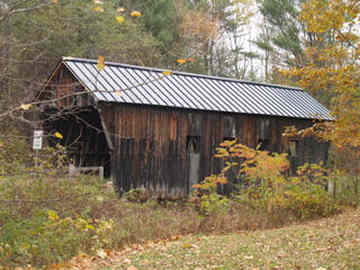 |
By Johnny Esau October 22,2005 |
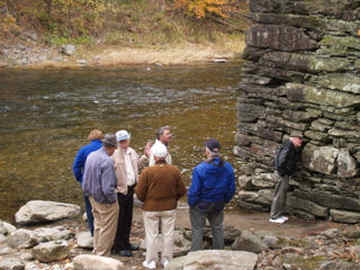 |
By Johnny Esau October 22,2005 |
Return to Top
By Joe Nelson
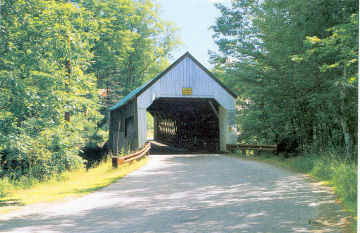 |
Photo by Joe Nelson July 1996 |
Committee members in attendance: Mike Hedges, Pam Thurber, Warren Tripp, Bob McCullough, Eric Gilbertson, Nancy Boone, Scott Newman and Sue Scribner. Project Manager Roger Whitcomb and John Weaver were also in attendance as was Neil Daniels representing the Vermont Covered Bridge Society and Gary Katz and Henrik Van Loon from the Town of Newfane.
This meeting was a follow-up to previous meetings to discuss the latest two proposals under consideration. They are as follows:
1) Rebuild the covered bridge using all new timber but same dimension/ design as the existing covered bridge.
2) Sister all of the existing lattice members (all of which have the ends cut off) by super- imposing new sister members directly over the existing lattice members as well as adding an additional layer to the upper and lower bottom chords.
Both scenarios were presented by project manager Roger Whitcomb with the clarification that glulam deck panels are suggested. Sacrificial full width running planks were also suggested. It was clarified that the rehabilitation will likely take a full construction season and that a temporary bridge will be necessary.
It was stated that there is a lot of rot in the south side of the bridge along with a lot of bolt holes. It was questioned whether or not the 2nd proposal would be a long term fix for the bridge. This then led to questions as to whether or not the bridge would need disassembly. Also it was asked if the glulam beams currently in place and supporting the bridge could be somehow moved in to support the bridge while any rehabilitation work was being done. Both Warren Tripp and Neil Daniels did not feel that this was feasible.
There was considerable discussion as to predicting how much of the original fabric could be saved from the original bridge, particularly in the upper chord as there is rot evident and new members bolted in. While not fully known until work begins, there were opinions expressed that the upper chords should not be touched unless absolutely necessary. It was also suggested that the roof be extended to offer protection to the trusses although some questioned whether this would be of any value. The Town reported that the town voted in March, 2000 for a new 1-lane covered bridge, but as long as a covered bridge remained, they felt that the Newfane voters would be happy with either option.
After additional discussion, a motion was made to vote to approve the rehabilitation option that involves sistering the lattice members and chords (Option 2). It was seconded and then amended to vote to keep the 1978 upper chord bolted members in place if possible.
With the Town voting as well as the permanent committee members, there were 7 votes to approve, 1 in dissension and 1 abstaining vote.
In dissent, Scott Newman stated that he did not feel that the limited amount of original fabric preserved in this rehabilitation warranted what he perceived to be substantial changes to the original design and would instead favor the reconstruction of the original design with such modifications required to meet required loading. However, with the vote taken, this will place the bridge in Category B of the Priority of Uses and the Priority of Treatment will be Number 3 per the Historic Covered Bridge Preservation Plan. There was a second motion made, seconded and amended to read that the project manager would be given the option of recommending for clearance by the VTrans Preservation Officer that the roof line of the bridge be extended if it seems warranted and beneficial after additional study. This was unanimously passed.
Respectfully submitted,
Susan Scribner, Committee Chair
Return to Top
by Charlie Elflein
Bridges have always fascinated me. As a youngster, I remember looking at pictures of famous structures like the Brooklyn, George Washington and Golden Gate bridges. In fact, one of my most memorable Christmas gifts was a book I received on the construction of Verrazano Narrows Bridge back in the early 1960s. My parents even took me to the site when this famous span was being built to connect Brooklyn and Staten Island in New York City. I knew then and there that bridges would be an important part of my life.
Back in June of 1969, my family was deciding where to go on a short vacation. Having the desire to explore Vermont, I suggested we plan a trip to the Green Mountain State. Dad always wanted to visit Shelburne Museum, and mom was keen on the idea of seeing some of the state's picturesque villages. We therefore decided to go "See Vermont," as the license plates read back then.
Getting out the 1969 Vermont Official State Map, we planned our route traveling north as far as Burlington, east through the Green Mountains to Montpelier, then home via the Connecticut River Valley. Little did I know this trip would introduce me to a hobby like no other ... covered bridging!
I can even remember the day I became interested in covered bridges. It was June 23, 1969. We had just photographed the State House in Montpelier and planned to follow Route 302 east to Wells River. Dad and I glanced at the map and noticed a concentration of covered bridges along Route 110 between Chelsea and South Tunbridge. This sounded interesting, so we changed our itinerary a bit.
June 23rd was a rather misty, overcast day, but the landscape had a very appealing look. As we drove south from Chelsea, the rolling hillsides and small farms were absolutely beautiful. Everything looked so green, peaceful and unspoiled. Truly Vermont at its finest.
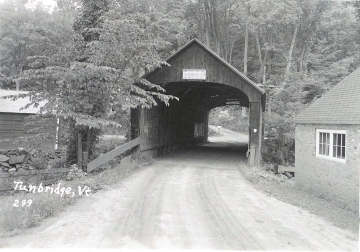 |
Tunbridge, Vermont |
Similar to the former Market Bridge on Route 110 at the north end of Tunbridge village, this multiple-kingpost truss had no lateral bracing between the upper chords. This is an oddity in covered bridge construction, but both structures had wooden beams high up connecting the roof rafters.
Continuing southward past the Tunbridge Fairgrounds, shortly ahead was Cilley Bridge peacefully waiting across an open meadow. Turning off Route 110 and driving by the little cemetery, there ahead stood the fine old covered span in its gorgeous rural setting. The surrounding hills and green fields here really impressed me. On that overcast day, cows were enjoying a buffet of early summer grass.
Driving on the unpaved road up to the multiple-kingpost bridge, there were electric fences to keep the bovines where they belong. At the time, Cilley Bridge had square portals, not quite as graceful as those of its upstream neighbor, but the setting more than made up for it. Even to this day, I would be hard-pressed to
name any covered bridge anywhere with a more pleasing rural setting.
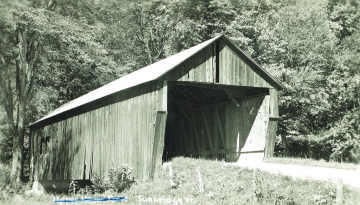 |
Tunbridge, Vermont |
Like Mill Bridge, Cilley is unpainted and has a metal roof. It is a little bit wider, though, and was constructed on a slight skew over the First Branch of the White River. Similar to most covered bridges, it possesses lateral bracing to keep the span tight and strong. This was only a fraction cheaper than Mill Bridge to build. It cost $523.35 when erected in 1883. Try constructing a bridge today for that amount!
On my first visit to these Tunbridge spans, I would say that I liked Mill for the bridge, and Cilley for its rural setting. Both of these old spans made a lasting impression on me, however. Even today, the Tunbridge area remains one of the nicest places in Vermont. Since the tourist throngs have not made inroads here, this area still feels like "real" New England. Let's hope it stays that way for many more years.
The greatest aspect of bridging is sharing our memories of these wonderful historic structures. Thanks to that "special day" back in June of 1969, I've experienced countless memories of many, many trips to see and photograph old covered bridges.
Return to Top
By Bill Caswell
Since our last update, the most significant enhancement to the Covered Spans of Yesteryear website (www.lostbridges.org) was the addition of details about 1,500+ past and present covered bridges in Pennsylvania. Most of this information came from Fred Moll's book Pennsylvania's Covered Bridges Our Heritage. Our thanks also go to Thomas Kipphorn for sharing his extensive knowledge and his Lancaster County photograph collection. Pictures of almost all of the bridges that ever existed in that county will most likely be available by the time you read this. Pictures of former bridges in Massachusetts have been added and Indiana pictures from the Dick Roy and Richard Donovan collections will be coming soon.
Work has begun on the tremendous volume of information that Miriam Wood has gathered on Ohio's covered bridges. Also, pictures of Canadian bridges are being scanned and information from both areas will be appearing during the coming months. Be sure to visit the website often and also sign up for our mailing list to hear about updates as they become available.
If you are interested in offering information or pictures of lost bridges in your area and have the ability to scan them, please contact me at: bill@lostbridges.org. Email is usually the most effective way to contact me, but if you do not have access to email, please feel free to write me at: Bill Caswell, Jr., PO Box 2242, Concord, NH 03302-2242. We have established a number of contacts, but are still lacking in certain areas. Specifically, there is a need for people with knowledge of lost bridges in the southeastern states. If you can help in this area, please let us know. There is still a vast amount of territory to cover and any help will be greatly appreciated.
Return to Top
Marlboro, Vt. - School teacher Johnny Esau's fourth-grade class at the Marlboro Elementary School built a lattice truss covered bridge, five-feet wide, 15-feet long, after the style of the Silk Road Bridge in Bennington, Vt.
Esau has taught his classes about covered bridges throughout his 25-year career, using the bridges to teach his students their required subjects, including architecture, and history.
The students built toothpick models to learn the science and physics of structural loading. Esau and his class have traveled throughout Vermont looking at bridges while exploring Vermont geography.
Esau had wanted to build a bridge that people could walk through. His ambition was finally realized in his last year before his retirement. His students began building the bridge during the schools winter sessions. In May, 2004, the students began to lay out the more than one-hundred pieces of the bridge on the school grounds. With the help of parents and community members, the bridge was assembled.
"It's amazing," said Esau. "I looked at what we accomplished. It's so sweet."
[This article based on an article from the May 5, 2004 edition of the Brattleboro Reformer, written by Howard Weiss-Tisman. Our thanks to Johnny Esau for forwarding the clipping. - Ed.]
September, 2005, Zumbrota, Minnesota - Formed in 1964 to preserve Zumbrota's covered bridge, the Zumbrota Covered Bridge Society has disbanded due to lack of interest, said Society member Charley Buck in a Post Bulletin article by reporter John Weiss.
"I'm sorry to tell you that we have disbanded as of September," wrote Alma Swanson, society president, in a letter to the Vermont Covered Bridge Society. "I feel bad about this as I started the society in 1964, we could not get help, no one would take any office so there was no alternative but to fold up . . . We always had such a nice time when we got together . . . we would have 30 people at a meeting, but so many have passed away and no young people to support us."
Quoting from the Post Bulletin article:"'No one pays attention to it,' Buck said." "The society formed to care for the old bridge, the only original covered bridge in the state. The city now owns it and is caring for it. The society has about $2,000 left and will divide that between the city and the local historical society."
"The city plans to put on a new coat of red paint . . . because of the town's 150th anniversary in 2006 . . ."
According to the 1989 edition of the World Guide to Covered Bridges, published by the National Society for the Preservation of Covered Bridges, the 120-foot bridge, WGN 23-25-01, was built in 1869 using a lattice truss variation.
According the Post Bulletin article the bridge was to be burnt in 1932, it being too narrow for cars. The town saved it and moved it to the county fairgrounds. It was moved again in 1970 to the Covered Bridge Park. Then in 1997, "the bottom wood began to rot." (The lower chords?.) The bridge was repaired and put back over the river.
[Our thanks to Alma Swanson for her letter and sending us the Post Bulletin clipping. - Ed.]
Bridgeton, IN, September 6, 2005 - According to Inside edge Business E-Newsletter InsideIndianaBusiness.com Report, Parke County Commissioner Jim Meece says a fair amount of money has already been raised for the effort of replacing the destroyed covered bridge.The business community in the Parke County area has come out in force to help reconstruct the Bridgeton covered bridge that was burned down in an arson fire earlier this year.
Parke County Commissioner Jim Meece says the county has collected more than $100,000 of the estimated $300,000 needed for the project. Meece says local businesspeople have also committed to giving their time, labor and supplies once a Terre Haute architectural firm completes blueprints for the new bridge. That bridge will look the same as the old structure. However, it will include several fire-prevention components, including a sprinkler system and fire retardant timber treatments.
Meece says the county's Covered Bridge Festival is expected to bring in as much as another $100,000 when it begins later this month.
[Source: Inside Indiana Business and Network Indiana/WIBC. Thanks to James Crouse for forwarding this article - Ed.]
by Dick Wilson
September 24, 2005 Booneville, N.Y. - The dedication of the Boonville Covered Bridge was a great success. The day was just beautiful and many people attended the ceremony. Here are some clippings from the paper that tell of the dedication. The covered bridge society’s were well represented with many members in attendance.
Here are a few pictures from the Booneville dedication. After I pounded in the last peg, I was presented with the hammer that was made from wood that went into the bridge. As you can see, it is a very nice bridge.
[For additional pictures from the day see www.vermontbridges.com - Ed.]
 |
Photo by Dick Wilson Sept 24, 2005 |
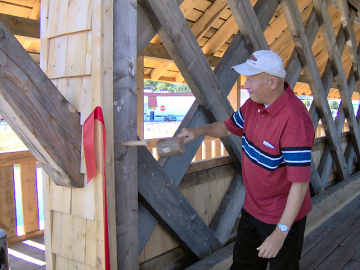 |
Sept 24, 2005 |
By John Weaver, P.E.
September 2, 2005 - Here are some pictures of Slaughterhouse (Northfield) and Moxley (Chelsea) Covered Bridges which were addressed under current Vermont Agency of Transportation contracts for stone repointing, fire retardant application, guard rail installation and other miscellaneous work. This work is being done under the National Historic Bridge Preservation Program, sometimes known as the Covered Bridge Program financed by Senator Jeffords' funds. This year, in Vermont, there were 15 covered bridge sites addressed under four separate contracts.
[See additional photos at www.vermontbridges.com - Ed.]
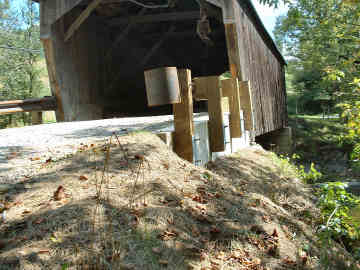 |
Photo by John Weaver |
 |
Photo by John Weaver |
October 8, 2005 - According to an article found on www.boston.com "Ashtabula County, with more covered bridges than any other county in Ohio, hopes to add another distinction: the longest wooden covered bridge in the United States."
[To see the full story go to http://www.boston.com:80/news/local/vermont/articles/2005/10/08/county_seeks_to_build_longest_covered_bridge_in_us - Ed]
Return to Top
![Joel Eastman or Redstone Bridge<br>Conway, NH WGN [29-02-04X], Photo by Dick Cull 1950'](wtbdge.jpg) |
Conway, NH WGN [29-02-04X] Photo by Dick Cull 1950's Timeframe |
Attached is an image of a covered bridge that was in a collection of Kodachrome slides from the 1950s that belonged to my wife's uncle, Mr. Dick Cull of Concord, Massachusetts. Dick liked the White mountains a lot, but I can't find this bridge in any publications I have. Would any members know which bridge is in this photo?
Thanks, Tom Hildreth
Hi Dick,
Can you help with this? I've scanned through the New Hampshire Covered Bridges book "A Link With Our Past" without seeing it.
YIB, Joe Nelson
Hi Joseph,
The bridge was the Joel Eastman or Redstone bridge in Conway, NH. The structure was arsoned, by suspected campers in the area, on July 4, 1975. WGN 29-02-04X
Dick Roy
Return to Top
 We have had many frosts here in New England and by the time you receive this issue of the newsletter, snow will probably be on the ground. Winter may not be here, officially, but we all know it is right around the corner. Please join me in welcoming Henry G. Rowse from Deland, Florida as a new member this quarter. We are also pleased to welcome the following new life members to our Society: Anthony Daniels, Weathersfield, VT, Richard and Ginger Hiscock, Vergennes, VT, Bob and Trish Kane, Sherburne, NY, and Joanna Titcomb, Perkinsville, VT. In my last column, I neglected to mention that Tom and Lisette Keating from North Tonawanda, NY were also new life members. Thanks to each of you for your support and faith in our Society by joining at this level. The holidays will soon be here. Save yourself a little time (and gas) and shop early for the holidays. We have some lovely covered bridge gift items on our website which you can view by visiting: www.vermontbridges.com. Or contact Joe Nelson for more information. All proceeds from the sale of these items support the mission of the Vermont Covered Bridge Society – to help preserve our covered bridges. A covered bridge book and/or a gift certificate for a membership to the Vermont Covered Bridge Society make lovely gifts and are another great way to promote our covered bridges. You Still Have Time! Don’t forget the Early Renewal Contest for 2006. All you have to do is pay your membership fees before the December 31st deadline. By doing so, you will qualify for a chance at a nice gift. The prizes for this year’s contests are: One year free membership to the VCBS; a lovely covered bridge welcome sign, or a gift bag filled with covered bridge items. To be eligible for this year’s contest, it’s simple…here’s all you need to do: Complete the membership form in this issue of the newsletter and return it with your check made payable to the VCBS no later than December 31st. The mailing address is: VCBS, PO Box 97, Jeffersonville, VT 05464-0097. Your name will then be put in the drawing for one of the three lovely prizes mentioned above. (Please note that if your membership has been paid in advance of this date, or if you are a life member, you will be included in the drawing). Keep in mind that only memberships paid by December 31st are eligible for this contest. Don’t wait until you get so busy with the holidays that you forget to send in your membership fee as you will miss out on some nice gifts. Do it today while you are thinking about it. Winners will be announced in the spring issue of The Bridger. Bob and I send along our warmest wishes for a wonderful and healthy holiday season. Happy Holiday’s to each and every one of you. Trish Kane Membership Coordinator Upcoming Birthdays and Anniversaries:
 Joe Nelson, P.O Box 267, Jericho, VT 05465-0267
Joe Nelson, P.O Box 267, Jericho, VT 05465-0267This file was coded by Steve Miyamoto This file posted December 20, 2005 |
